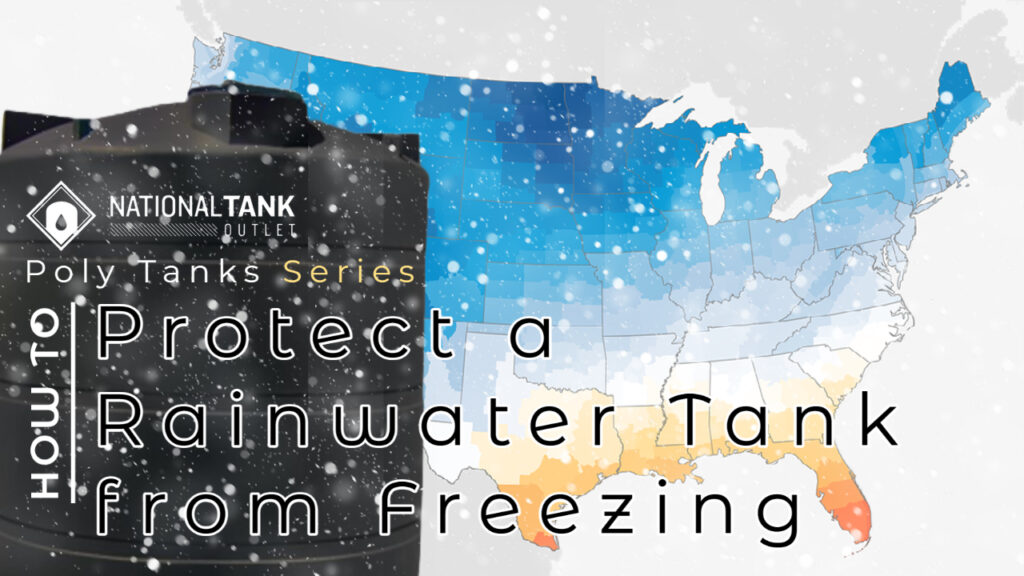
Freezing temperatures are both a challenge and concern for rainwater harvesting tanks and practice across much of the United States. Whenever winter arrives or sudden cold fronts come through, there may be water still left in a tank. This is especially true for rainwater systems that harvest large volumes of rainfall, setups with large storage tanks, or systems that rely on the harvested rainwater as a water source, such as for agriculture, livestock, or indoor water uses.
If rainwater remains in the tank during freezing temperatures, the water will not be available for use and could cause damage to the tank, plumbing and any connected equipment. In this Rain Tanks Series post, we will outline the main reasons why it can be bad to let a water tank freeze and recommendations on what can be done to keep the water in a tank from freezing.
While this post focuses on rainwater tanks, the methods presented can also be used to prevent freezing in standard water storage tanks.
Why Letting Water Freeze in a Rain Tank Should Be Avoided
After the main point that water frozen in a tank cannot be used, damage can be caused as the water freezes. During the freezing process, water will expand and increase the volume of space it occupies, also exerting a type of outward force pressure as it expands and solidifies. As this happens, if there is not sufficient space for the water to expand, it can press on the tank, fittings, and the lid.
Plastic polyethylene rainwater tanks are heavy duty containers and can withstand the force caused by freezing water and will not itself be damaged. On the other hand, fittings, the lid, and any equipment that may have water inside can be forced to come loose and/or be damaged in the process. Threads can be damaged and may require replacement. Seals or internal components on equipment such as water pumps can be damaged requiring repair or full replacement.
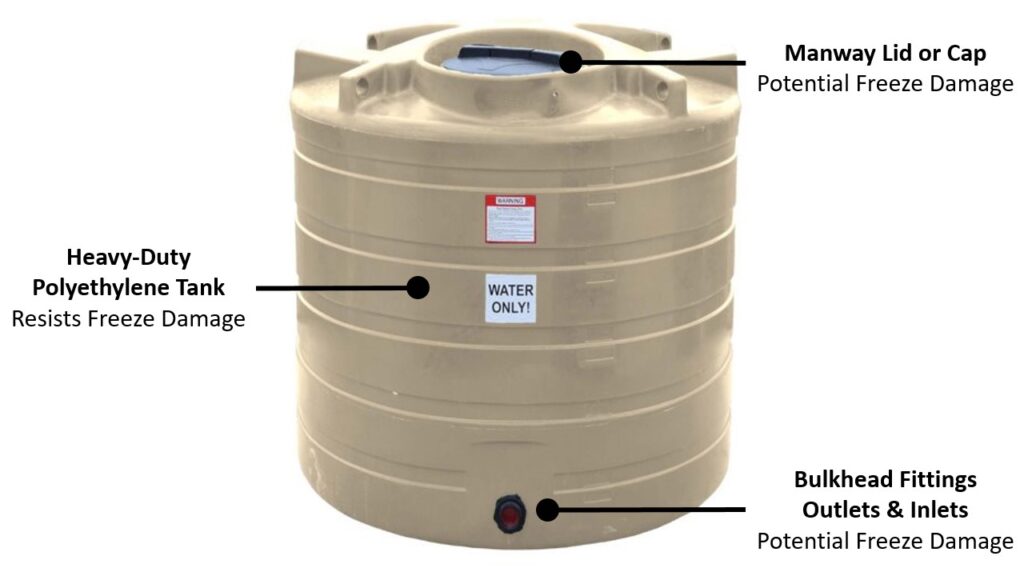
As a contrast to polyethylene plastic tanks, metal storage tanks can be damaged by water freezing within the container. Even though metal is in some ways a stronger material, metal does not provide the same flexibility and ability to expand as plastic does. If there is not enough extra space, the metal can be damaged by the expansion caused by freezing water. This is mostly a concern for solid metal tanks that do not use an internal polyethylene liner to hold the water as is common in galvanized steel rain tanks.
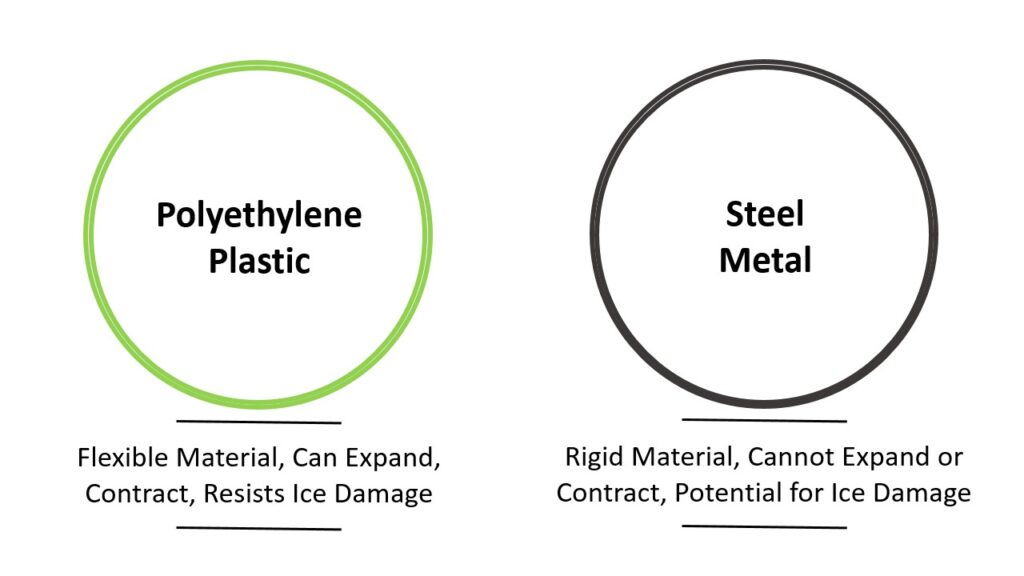
Factors Affecting the Likelihood of Water Freezing in a Storage Tank
There are several factors that affect the likelihood and concern for water freezing in a storage tank. The first factor is the storage size of the tank and the total volume of water currently being stored. The second factor is how cold outdoor temperatures get and for how long. These two points both play a role in whether the water in a tank will freeze and how quickly it will occur.
Due to physical laws and chemistry, a large volume of water will take longer to freeze compared to a small volume when at the same temperature. This is due to the greater length of time required for the energy exchange to cool a larger volume of water to the freezing point compared to a smaller volume of water. A larger storage tank will also resist the effects of freezing longer than a smaller tank, even if volumes are the same, due to the amount of extra space within the larger tank that will help to resist temperature change.
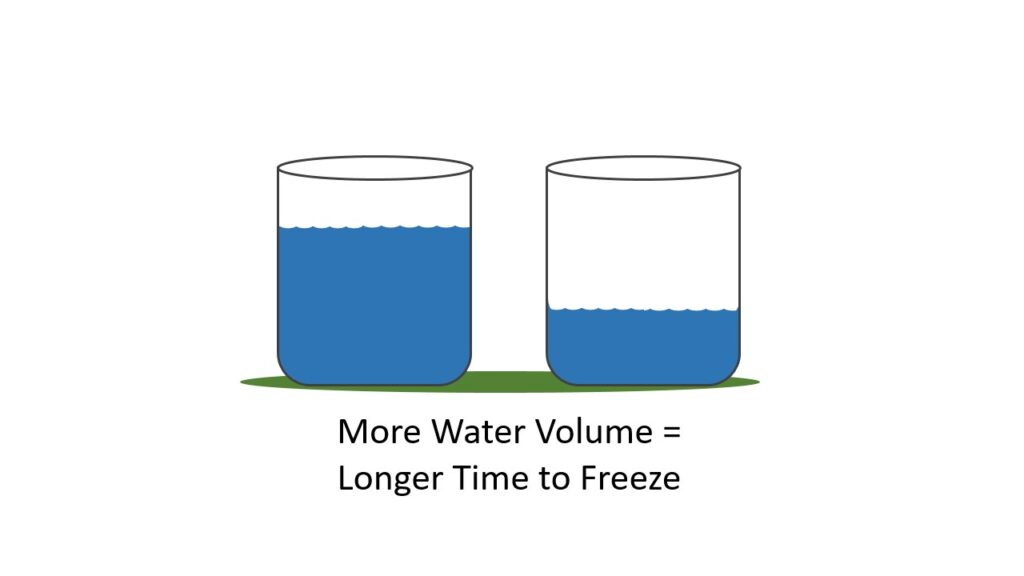
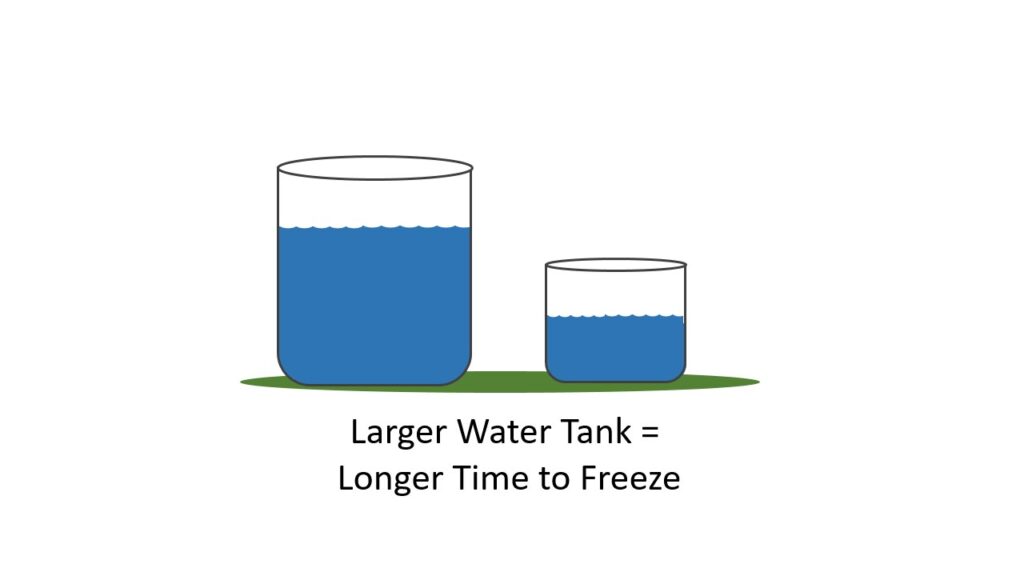
Consider two houses both similar except one is twice the size and both are heated to the same temperature. When no longer heated, it will take longer for the larger house to cool to outside temperatures compared to the smaller house. Outdoor water tanks are similar, except natural heating is done during the day by the sun.
Concerning outdoor temperatures, the colder ambient temperatures get beneath water’s freezing point of 32°F (0°C), the sooner that water within a storage tank will begin to freeze. When considered together with a large volume of water, it is entirely possible for the water not to freeze if temperatures sink to just below freezing overnight and are warmer during the day. This is due to the resistance of the bulk volume of water to temperature change. However, if temperatures are consistently below freezing or will be, then it should be expected for the water in the tank to eventually freeze.
How To Prevent Water from Freezing in a Tank: Several Options
There are several options available that can be successfully used to keep water from freezing in a rainwater tank or in a basic outdoor water tank. The option that may be best may depend on your select scenario, location and intended use for the water. Performing only one option may be sufficient in some cases while other cases may require the use of multiple methods. Locations with mild winters and temperatures fluctuating above and below freezing may require less effort and may be much easier to keep the water from freezing. While locations with extended subfreezing temperatures will require more effort and be more difficult to protect against the cold.
Option 1: Drain the Water
The first option to keep a water tank from freezing is a guarantee and will work every time no matter the location or how cold it gets. This option is to drain the tank of all available water. While it may not be the most preferred or viable option, especially if the water is needed for use or wanted for the following season, draining the tank and all connected pipes and equipment of any standing water will effectively eliminate the concern of freezing water.
Completely draining the water tank and its connections is the surest way to winterize a rainwater harvesting system and prevent any concerns from freezing and winter temperatures.
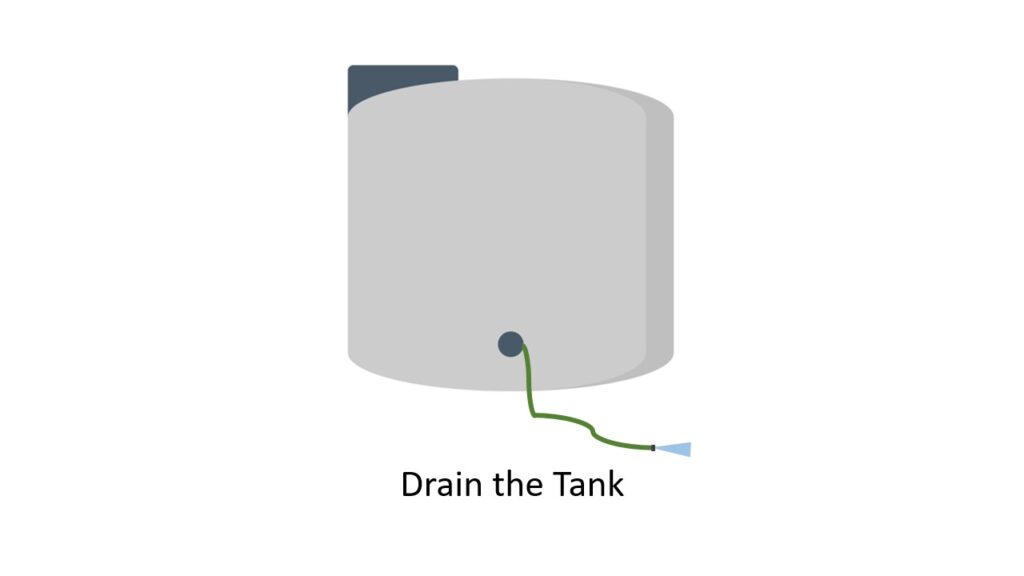
Depending on the volume of water, it may be recommended to drain the tank over several days and/or in different locations. If you know freezing temperatures are on the way, as a way to plan in advance, the water in the tank can be put to good use as it is drained, if such an option is available. When draining, always drain large volumes of water away from the foundations of structures to prevent damage.
To drain connected pipes and a water pump, (such as one that is not run-dry capable), the best option may be to disconnect the plumbing and allow it to drain. Choosing plumbing, fittings, valves, and water pumps with threaded connection options are best as they are easiest to disconnect and remove as needed.
Option 2: Insulate the Tank
The second option to protect a rainwater tank from freezing is to insulate the tank. There are several ways that this can be done. There are commercially available options and those that can be considered makeshift, DIY type options that may only be slightly effective up to a certain extent of cold and time. Commercial water storage tank insulation comes in two main types: (1) insulation wrap that you can buy and install yourself on an already owned water tank and (2) insulation that can be added over the entire tank by the manufacturer at purchase and prior to being shipped.
Commercial water storage tank insulation wraps can be available in different types made from different materials. These are often the same or similar to insulation wraps for water heaters or the wall insulation used in buildings. These insulation types may be available in different insulation ratings to suit different ranges of cold temperatures. When considered with the large volume of water within the tank, tank insulation wrapping can be an effective means to prevent freezing.
Insulation added by the manufacturer or supplier of the tank is often a polyurethane spray foam type insulation that is set over the entire tank and sealed with a weatherproof coating. This type of storage tank insulation is highly effective in protecting the stored water from ambient temperatures, both hot and cold.
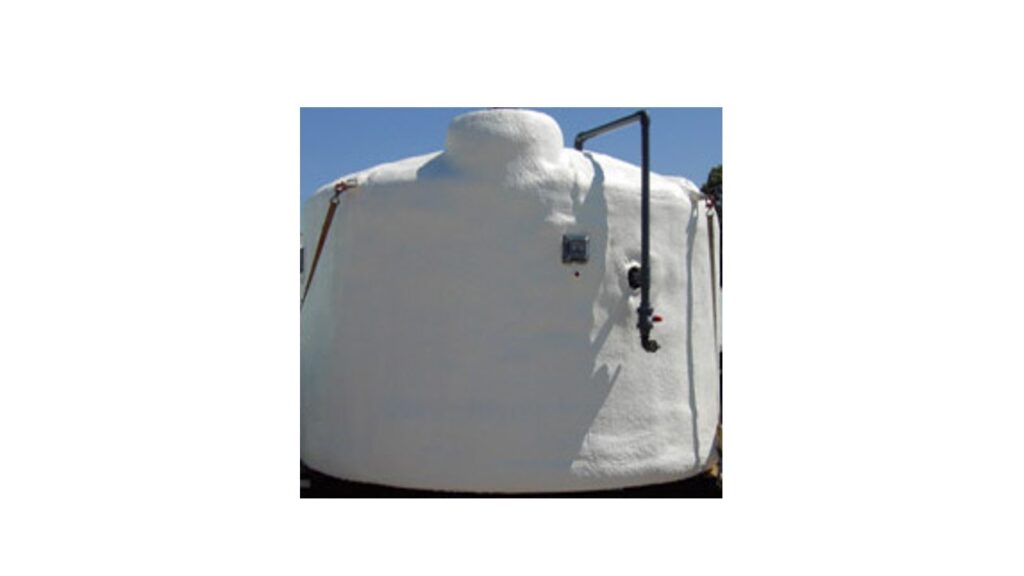
Makeshift DIY tank insulation options commonly used by individuals include throwing a blanket or blankets over the tank and stacking hay bales around the water storage tank.
Option 3: Use a Tank Heater
The third option to prevent water in a storage tank from freezing is to use a method to keep the water warm, such as a tank heater. Tank heaters are available in various types that provide different heating strengths suitable for different volumes of water. A common tank heater type is a submersible heater, also known as an immersion heater, designed to be placed inside the water tank. Such tank heaters are usually only suitable for smaller storage tanks and water volumes.
Another type of tank heating equipment is known as heat tracing. Heat tracing equipment are heating pads with wires that install on the outside of a storage tank and heat the stored contents through induction type heating. Heat tracing is often paired with polyurethane insulation and is installed beneath the insulation layer to protect the equipment from weathering and further improve the ability of the system to maintain stable temperatures. Heat tracing is best suited for locations with extreme cold weather and where freeze protection is vital to an application.
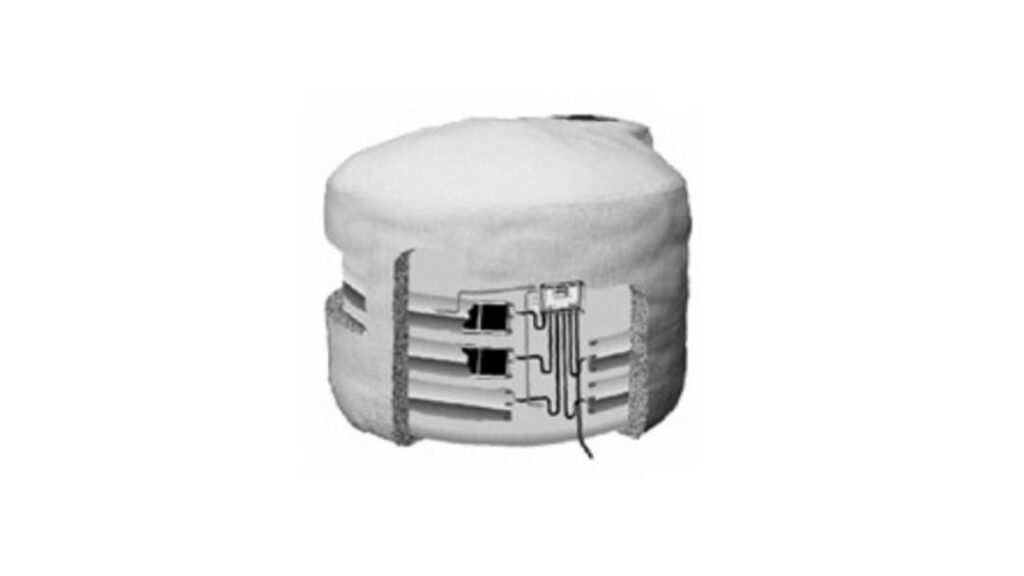
Option 4: Keep the Water Moving
The fourth option to prevent freezing is to keep the water moving within the storage tank by any means that is successful and consistent. Water that is moving requires significantly colder temperatures and a greater exchange of energy to freeze compared to water that is still.
For example, a still pond will freeze before a brook, which will freeze before a stream, which will freeze before a calm river, which will freeze before a rapid river. In fact, due to the volume of water in the last two examples and the movement of the rapid river, they may only ever freeze at the surface and never fully freeze under any normal scenario – demonstrating the ability of moving water to resist freezing.
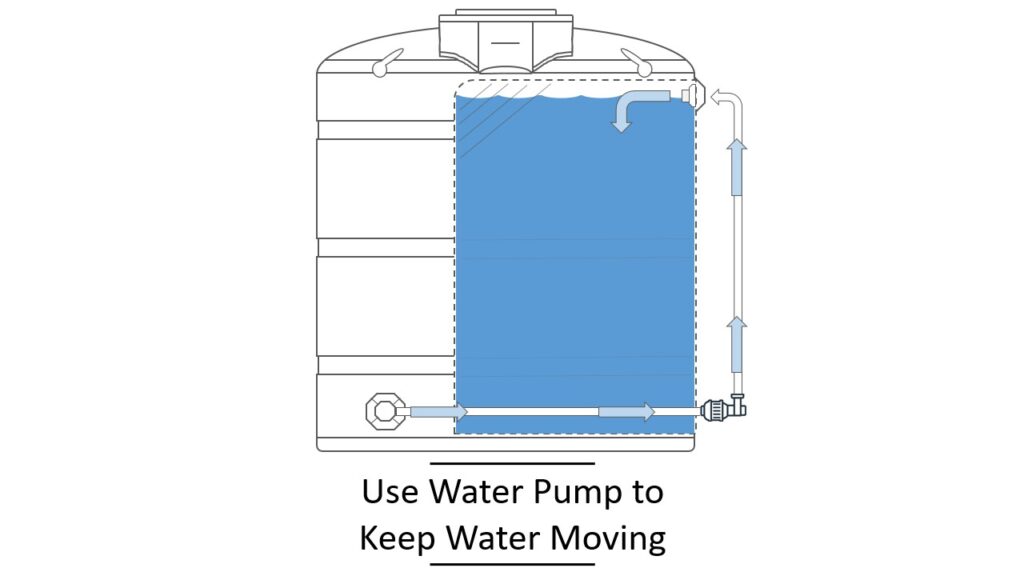
For a rainwater collection tank (or standard water storage tank), the water can be kept moving in one of two main ways. The first method is to create a kind of closed-loop system that uses a water pump and piping to continuously circulate the water out and back into the storage tank. The closed-loop system could feature a three-way valve that would allow the system to be opened for the water to be used as needed. This option would require a continuous duty pump capable of running non-stop or intermittently while temperatures are below freezing.
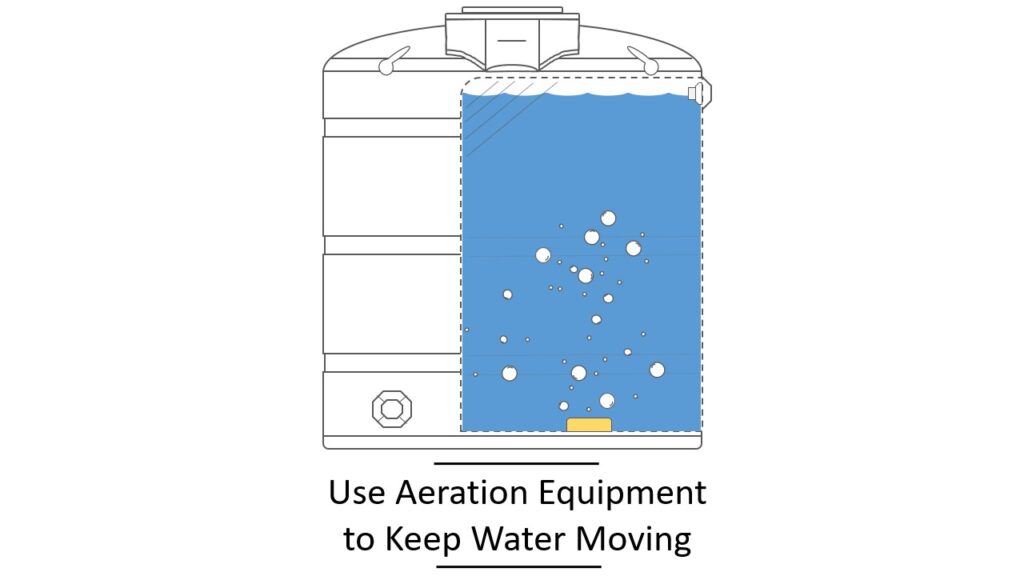
The second method is to add tank mixing equipment or aeration equipment with sufficient power to agitate the bulk volume of water and prevent freezing. This method, however, is best suited for smaller storage tanks as the equipment necessary for aeration of large water volumes is often designed, intended, and priced for commercial, industrial, and municipal type applications. Aeration may be acceptable for rain barrels, IBC totes, and water storage tanks up to 500 gallons.
Option 5: Install Tank Inside a Structure
The option to install the water tank inside a temperature-controlled structure will keep water temperatures similar to those inside the building. This option would eliminate the need for any additional methods of freeze protection but would also require a unique rainwater harvesting setup. Such a setup is not uncommon, however, and is often preferred for rainwater harvesting applications that will supply water indoors.
Structures that are not temperature controlled such as barns, sheds and the like will provide some protection and prolong freezing, but only for a time. This option is also well suited for standard water storage tanks.
Option 6: Use an Underground Tank
The sixth option in water tank freeze prevention is to use an underground tank. If properly done, installing an underground water tank can be as effective as fully draining the water from the tank. Correct underground water tank installation must be below the regional frost line. The frost line is the depth below the earth’s surface that consistently remains above freezing temperatures. How deep the frost line is, and the required burial depth for a tank, will depend on the geographic location due to average expected winter temperatures. In some locations the frost line may be 2 feet deep while as much as 6 feet deep in others.
In addition to freeze prevention, underground installation also provides the benefit of near stable water temperatures and protection from algae. Being insulated by the earth’s soil helps to maintain a consistent temperature for the water in an underground tank. Underground burial prevents sunlight exposure and therefore means no algae as algae require sunlight to grow.

Now, the option to use an underground tank will require the purchase and use of a tank engineered and built as an underground storage tank — making this option great as a starting point for new projects or as a replacement upgrade for an existing one. A dedicated underground water tank is manufactured to withstand the weight and pressures of burial, while above ground tanks are not made for burial and should not be used for this purpose.
With this said, there are many DIYers that choose to ignore this recommendation and install just the base of an above ground tank to a certain depth to take advantage of the earth’s warmth for freeze protection. While we cannot recommend this practice, as it holds the potential to affect the tank’s structural integrity and void a manufacturer’s warranty, there are many reports of the practice being successful in freeze prevention.
Recommendations for Basic Winterization of a Rainwater Harvesting Tank
If you live somewhere that experiences freezing temperatures on and off throughout the winter and do not want to collect any more water during warm days, it is recommended to fully winterize your rainwater harvesting system. A rainwater harvesting system can be winterized by draining the tank and equipment, allowing them to dry, and diverting any future rainwater away from the storage tank. Diverting rainwater can be done by taking off the bottom valve on a first flush diverter and using it instead as a downspout. Another option is to set up alternative plumbing to reroute the main to discharge rainwater onto the ground rather than to the rain tank.
Takeaway | How to Prevent Water from Freezing in a Storage Tank
There isn’t significant research on the amount of time it takes for the water in a storage tank to freeze. There are several variables to consider: the tank material, thickness, design, size, current volume, outdoor temperatures, temperature fluctuations, sunlight, wind, weather and more. The options presented in this Rain Tanks Series post are provided as recommendations and not as a guarantee. While many of the methods presented are effective and can work to prevent water tank freezing, only draining the tank and underground installation are the most certain to work if performed properly.
A method of prevention will be required in most cases to keep water in a storage tank from freezing. Exclusions may apply to large volumes of water, such as those in excess of 20,000 gallons, and tanks installed underground beneath the regional frost line. Even large water volumes may be susceptible to freezing in areas with extreme winter temperatures if additional methods are not taken. The other, most effective ways to prevent water tank freezing are to insulate the tank, keep the water heated, and to keep the water moving.
We hope this post has helped shed some warmth on the topic of winter freeze prevention in rainwater harvesting tanks and water storage tanks alike. Check out our other Rain Tank Series posts for more information on rainwater harvesting practices, setup, and systems. If you have further questions or require assistance in selecting the right equipment for implementing your own rainwater harvesting system, contact us. Our support staff and knowledge experts will be glad to help.